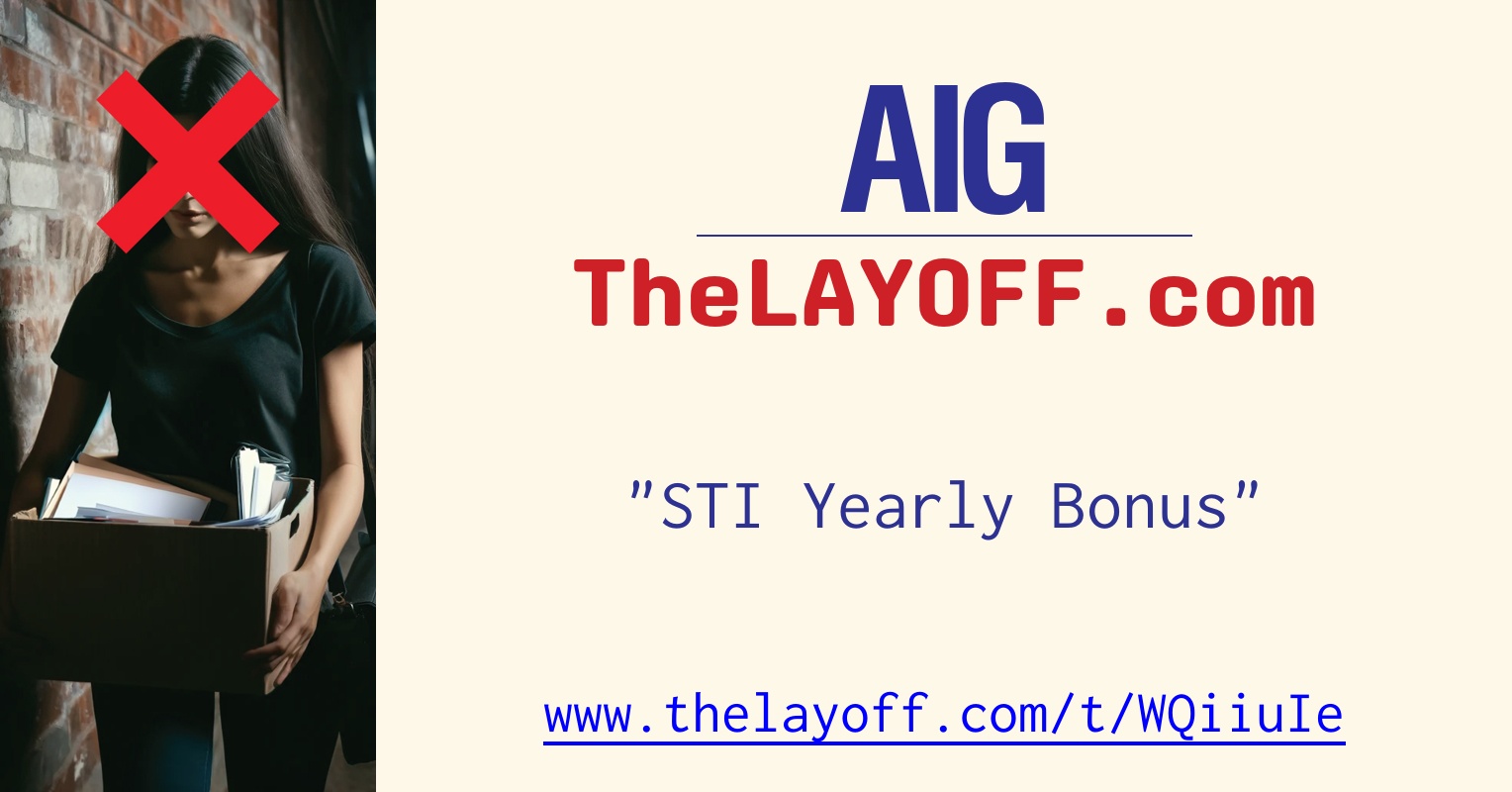Navigating Layoffs At AIG: Understanding The Impact & Future Outlook
The global economic landscape is in constant flux, marked by periods of unprecedented growth and, inevitably, challenging downturns. In such environments, even the most established and robust corporations find themselves at a crossroads, often leading to difficult decisions regarding workforce adjustments. The topic of layoffs at AIG, a titan in the insurance and financial services sector, brings into sharp focus the broader economic pressures impacting large enterprises and the human element behind corporate restructuring.
While the headlines often spotlight the dramatic shifts in the tech world, with companies large and small announcing significant workforce reductions, the reality is that no sector is entirely immune. The financial services industry, including giants like AIG, constantly evaluates its operational efficiency, market position, and strategic direction in response to evolving economic conditions, regulatory changes, and competitive pressures. Understanding the multifaceted reasons behind such decisions, their profound impact on individuals, and the broader implications for the market is crucial for anyone navigating today's complex professional world.
Table of Contents
- The Shifting Sands of the Global Economy: A Context for Layoffs
- Understanding the Broader Layoff Landscape
- Why Large Corporations Like AIG Consider Workforce Reductions
- A Historical Perspective on Layoffs at AIG (and the Industry)
- Navigating Economic Headwinds in Financial Services
- The Human Impact: Beyond the Numbers of Layoffs at AIG
- Strategies for Employees Affected by Layoffs at AIG
- The Importance of Resilience and Adaptability
- AIG's Future Trajectory: Adapting to a Dynamic Market
- The Role of Continuous Adaptation in Corporate Longevity
- Monitoring the Pulse of the Job Market: Staying Informed
The Shifting Sands of the Global Economy: A Context for Layoffs
The past few years have been a rollercoaster for the global economy. From the initial shockwaves of a pandemic that forced businesses to adapt overnight, to subsequent supply chain disruptions, inflationary pressures, and rising interest rates, the landscape has been anything but stable. These macroeconomic forces ripple through every industry, influencing consumer spending, investment decisions, and ultimately, corporate hiring and retention strategies. While the focus often falls on the tech sector, the cumulative damage of startup layoffs has been severe, with 500 tech companies having now laid off 64,000+ employees during the pandemic. This pervasive trend sets a challenging backdrop for all businesses, including financial giants like AIG.
Understanding the Broader Layoff Landscape
It's not just the tech behemoths making headlines. This past week saw layoffs from a number of notable startups, including 4(!) data analytics companies (Mixpanel, Segment, Mode Analytics, and ThoughtSpot). This indicates a broader re-evaluation across various industries, driven by factors such as over-hiring during boom periods, the need for increased efficiency, or a shift in market demand. Even companies like Uber just announced another mass layoff today, and WeWork expects to continue performing rolling layoffs through the end of the month. This ongoing, sometimes staggered, nature of workforce reductions highlights a cautious approach by many companies, trying to right-size their operations for a potentially leaner future.
However, it's not all doom and gloom. The market is dynamic. Even startups that cut employees earlier in the year have rebounded, demonstrating resilience and adaptability. We end the year with just 4 recorded layoffs in December, suggesting that the pace can slow, and some sectors find their footing again. There are even top 10 layoff comeback stories of companies that have navigated these turbulent waters successfully. This mixed picture underscores the complexity of economic cycles and the strategic decisions companies must make to survive and thrive. For a company like AIG, which operates in a highly regulated and sensitive financial market, these broader trends are keenly observed and often inform internal strategic planning.
Why Large Corporations Like AIG Consider Workforce Reductions
For a company of AIG's scale and stature, decisions about workforce reductions are never taken lightly. They are typically the result of extensive analysis and are driven by a confluence of strategic imperatives rather than simply a reaction to a single event. Here are some primary reasons why a large financial institution might consider layoffs:
- Economic Downturns and Market Volatility: A global recession or significant market instability can directly impact AIG's core businesses, such as insurance premiums, investment returns, and client demand for financial products. When revenue forecasts decline, companies often look to reduce costs, with personnel being a significant expenditure.
- Strategic Restructuring and Divestitures: AIG, like many large conglomerates, has undergone periods of significant restructuring, including divesting non-core assets or streamlining operations to focus on more profitable segments. Such strategic shifts often lead to the elimination of roles that no longer align with the company's new direction.
- Technological Advancements and Automation: The financial services industry is increasingly embracing automation, artificial intelligence, and digital transformation. While these technologies enhance efficiency and customer experience, they can also reduce the need for human intervention in certain back-office operations, claims processing, or data analysis, potentially leading to layoffs at AIG in specific departments.
- Efficiency Drives and Cost Optimization: Even in stable economic times, large corporations continually seek ways to optimize operations and reduce overheads to improve profitability and competitiveness. This can involve consolidating departments, outsourcing certain functions, or implementing leaner organizational structures.
- Regulatory Changes: The financial and insurance sectors are heavily regulated. New regulations can sometimes necessitate changes in business models or operational structures, which might lead to a reallocation of resources or a reduction in staff in certain areas.
- Mergers and Acquisitions: While not a direct cause of layoffs at AIG in recent times, mergers and acquisitions are common in the financial sector. When companies combine, there is often an overlap in roles, leading to redundancies and subsequent workforce reductions.
A Historical Perspective on Layoffs at AIG (and the Industry)
AIG has a long and complex history, notably its pivotal role and subsequent government bailout during the 2008 financial crisis. That period saw significant restructuring and workforce reductions as the company navigated its recovery and repaid taxpayer funds. While that was an extreme circumstance, it illustrates how major economic shocks can necessitate drastic measures, including widespread layoffs. In the years since, AIG has worked to streamline its operations, shed non-core businesses, and focus on its primary insurance segments.
Navigating Economic Headwinds in Financial Services
The financial services industry, by its very nature, is highly susceptible to economic cycles. Unlike tech startups that might experience rapid boom-and-bust cycles due to venture capital funding or speculative growth, established financial institutions like AIG often face more gradual but equally impactful shifts. These can include prolonged low-interest-rate environments impacting investment income, increased competition from fintech companies, or changes in consumer behavior demanding more digital-first services. To remain competitive and profitable, these companies must constantly adapt their workforce and operational models, which can sometimes involve difficult decisions about staffing levels. The broader trend of companies like Uber and WeWork performing rolling layoffs through the end of the month also reflects a cautious and adaptive approach that large, established companies like AIG might also adopt, ensuring they are lean and efficient for future challenges.
The Human Impact: Beyond the Numbers of Layoffs at AIG
While corporate announcements of layoffs often focus on numbers and financial implications, the true weight of these decisions is felt most acutely by the individuals affected. Losing a job, especially from a long-standing and reputable institution like AIG, can be a profoundly disruptive experience, impacting not just financial stability but also mental and emotional well-being. The cumulative damage of startup layoffs has been severe for many, and the experience for employees at a large, established firm is no different.
- Financial Strain: The immediate concern for most is the loss of income, which affects household budgets, mortgage payments, and future financial planning. Severance packages, while helpful, are often temporary bridges.
- Emotional and Psychological Toll: Layoffs can lead to feelings of shock, anger, sadness, and a significant blow to self-esteem. The uncertainty of the job search, coupled with the feeling of being suddenly adrift, can cause considerable stress and anxiety.
- Career Uncertainty: Navigating the job market, especially for specialized roles within financial services, can be challenging. Individuals may question their career path, skills, and future prospects.
- Impact on Remaining Employees: Even those who remain at AIG can experience a ripple effect. Morale can drop, and there may be increased workload, fear of future cuts, and a sense of unease about the company's stability.
Strategies for Employees Affected by Layoffs at AIG
For those who find themselves impacted by workforce reductions, whether at AIG or any other major corporation, proactive steps are essential for navigating the transition successfully. But once the smoke clears from those initial announcements, the real work begins.
- Assess Your Financial Situation: Understand your severance package, unemployment benefits, and create a realistic budget for the interim period.
- Update Your Professional Profile: Refresh your resume, LinkedIn profile, and professional portfolio. Highlight achievements and quantifiable results.
- Network Actively: Reach out to former colleagues, industry contacts, and mentors. Networking is often the most effective way to find new opportunities. Attend industry events, virtual or in-person.
- Upskill or Reskill: Consider online courses, certifications, or workshops to acquire new skills or enhance existing ones, making yourself more marketable in a competitive environment.
- Prioritize Mental and Physical Well-being: Job loss is stressful. Engage in activities that support your mental health, seek support from friends, family, or professionals if needed.
- Explore Different Paths: This could be an opportunity to explore a different industry, start a consulting business, or pursue a long-held passion.
The Importance of Resilience and Adaptability
The stories of companies that rebound after significant cuts, or individuals who thrive after a layoff, underscore the importance of resilience. Just as "Even startups that cut employees earlier in the year have rebounded," individuals too can leverage this period as an opportunity for growth and redirection. The ability to adapt to changing circumstances, learn new skills, and maintain a positive outlook are invaluable assets in today's dynamic job market. Here are our top 10 layoff comeback stories of individuals who successfully navigated this challenge, offering inspiration and practical takeaways.
AIG's Future Trajectory: Adapting to a Dynamic Market
For AIG, like any other major financial institution, the path forward involves continuous adaptation. This means not only responding to immediate economic pressures but also proactively shaping its business for future growth. This includes investing in digital transformation, enhancing customer experience, and exploring new product offerings that align with evolving market needs. The focus on efficiency and agility that might lead to layoffs at AIG in certain areas is often balanced by strategic hiring in others, particularly in high-growth or technologically advanced domains.
The Role of Continuous Adaptation in Corporate Longevity
The longevity of companies like AIG hinges on their ability to anticipate and respond to market shifts. This proactive approach often involves strategic workforce planning, which might include re-skilling existing employees, optimizing team structures, and making difficult decisions about roles that are no longer central to the company's future. The insights gained from broader market trends, such as the significant number of tech companies laying off employees, inform how established firms like AIG approach their own workforce strategies, aiming for sustainable growth rather than reactive cuts.
Monitoring the Pulse of the Job Market: Staying Informed
In an era where economic news and employment trends can shift rapidly, staying informed is paramount for both employers and employees. Understanding the broader context of workforce changes, whether it's a slowdown in tech hiring or strategic adjustments at a financial giant, provides valuable perspective. This page is constantly being updated, reflecting the dynamic nature of the job market and economic conditions. For those keen on keeping abreast of these developments, you can get monthly updates about layoffs sent straight to your inbox, providing timely insights into the employment landscape.
The discussion around layoffs at AIG, or any major corporation, is a microcosm of the larger economic narrative. It highlights the constant tension between corporate efficiency, market demands, and the human cost of business transformation. As the global economy continues to evolve, adaptability, informed decision-making, and a focus on human resilience will be key for navigating the challenges and seizing the opportunities that lie ahead.
Conclusion
The topic of layoffs, whether broadly across the tech sector or specifically concerning layoffs at AIG, is a complex one, deeply intertwined with global economic forces, corporate strategy, and individual lives. We've explored the broader context of workforce reductions, noting how the cumulative damage of startup layoffs has been severe, yet also acknowledging that even companies that cut employees earlier in the year have rebounded. We've delved into the multifaceted reasons why large corporations like AIG might consider such measures, from economic pressures to strategic restructuring and technological advancements. Most importantly, we've emphasized the profound human impact of these decisions and offered actionable strategies for those affected to navigate the challenging transition.
The financial services industry, including giants like AIG, continues to adapt to a dynamic market, focusing on efficiency and long-term sustainability. While discussions about layoffs are inherently difficult, they are a stark reminder of the ever-changing nature of the professional world. Staying informed, developing resilience, and embracing continuous learning are crucial for both organizations and individuals to thrive in this evolving landscape.
What are your thoughts on the current job market trends, especially in established sectors like financial services? Have you or someone you know been impacted by recent workforce changes? Share your experiences and insights in the comments below. Your perspective can help others navigate these challenging times. For more in-depth analyses of economic trends and career advice, explore other articles on our site.

Selling employees to make money - post regarding AIG (American Intl

STI Yearly Bonus - post regarding AIG (American Intl Group Inc

verp - post regarding AIG (American Intl Group Inc.) layoffs